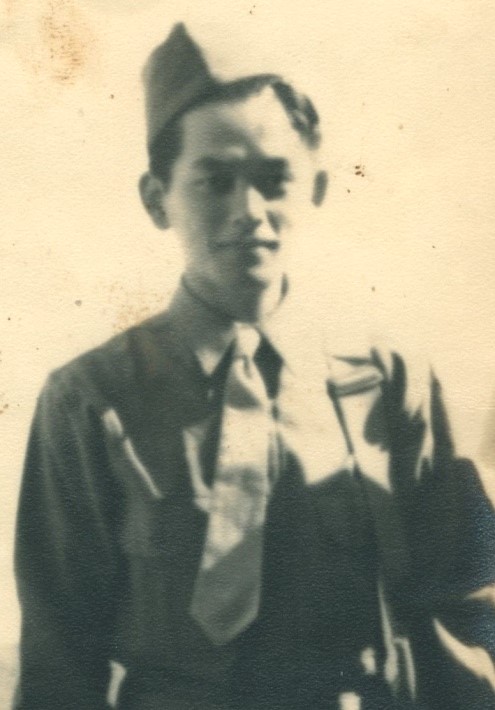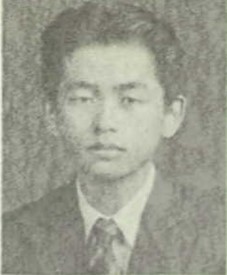
Samuel Tomoichi Goto
Technician 4th Grade
442nd Regimental Combat Team
522nd Field Artillery Battalion, C Battery
Tomoichi Goto was born on February 13, 1922, in Papaaloa, Hawaii island, Territory of Hawaii. He was one of two daughters and four sons of Takuichi and Shizuyo (Awada) Goto. Takuichi arrived in Hawaii on the Nippon Maru on May 29, 1908, from Arima, Agina District, Hiroshima Prefecture, Japan, and he worked on a sugar plantation. Shizuyo was born in Hawaii in 1900 and her parentsYejiro and Mika Awada were also from Hiroshima Prefecture.
Tomoichi was raised at Amauulu Camp No. 1 near Hilo. He graduated from Hilo High School in 1940. That summer he was among a number of Hilo youths who were initiated into the Young Buddhists Association (YBA). By 1942, he had moved to Honolulu to attend Cannon Business School. It was there that he signed his World War II Draft Registration card on June 30, 1942, Local Board No. 3, National Guard Armory. He was a student, living at 2970 Harding Avenue, and his point of contact was George Hirasa of the same address. Tomoichi was 5’3¼” tall and weighed 105 pounds.

On August 1, 1942, he graduated from Cannon after a course in bookkeeping and accounting.
Tomoichi enlisted in the U.S. Army on March 24, 1943, in Honolulu, and his civilian occupation was listed as “Bookkeeper/cashier.” In his own words, he later wrote: “The only reason I volunteered is because there [was] no one else in my family or anyone else among my relatives who [was] available to volunteer. I was working for the First Insurance Co. and I was the only volunteer from this company. From my hometown, there were three of us. One was a battlefield casualty.”
He was at Schofield Barracks in the Tent City of new enlistees for the 442nd. On March 28, 1943, Goto was among the hundreds of new soldiers who were given a community farewell ceremony at Iolani Palace. The unit left on April 4 on the S.S. Lurline for San Francisco, then on to Camp Shelby, Mississippi, by train.
Once at Camp Shelby, the new 442nd Regimental Combat Team went through basic training from May 1 to August 23, and then specialized training depending on their unit. Tomoichi had been assigned to C Battery of the 522nd Field Artillery, the 442nd’s artillery arm. From November 15, 1943, to January 1944, the 522nd was on winter field maneuvers in Louisiana and then returned to Camp Shelby. They later left to participate in the last three of the “D” Series maneuvers in the DeSoto National Forest in Mississippi.
Goto’s family later asked him if the drill instructors were mean to the Nisei soldiers, and he wrote: “The drill instructors in our battery were typical military men. I did not feel any meanness.” As for relations with mainland Nisei, “I read that the Niseis from Hawaii and the mainland did not mix well, but I didn’t see it in our battery. In fact, personally I got along very well with the mainland Niseis.” He was assigned to be a cook and, as he said, “…probably …because I weighed approximately 100 pounds. My duties were to prepare the meals prescribed by the military manual. …I was very lucky that I was in the field artillery.”
After a year of training, on April 22, 1944, the unit left Camp Shelby by train to Camp Patrick Henry, Virginia. On May 2, the 522nd left Hampton Roads on the USAT Johns Hopkins in a convoy of over 100 troop ships, arriving at Brindisi and Bari, Italy, on May 28. They went by train to Naples, arriving on May 29, where they met up with the rest of the 442nd. After a week in a bivouac area in the nearby town of Bagnoli, they left on the LST 526 for Anzio, arriving on June 7.
The 522nd went into battle with the 442nd on June 26 near Suvereto in the Rome-Arno Campaign, ultimately driving the German Army north of the Arno River. Tomoichi was present for all the action seen by the 442nd in Italy.
Then the 442nd was selected to join the battle in France. On September 10, 1944, the 522nd Battalion left Rosignano, Italy, on the S.S. Richard K. Call for the overnight trip to Qualiano, where they were in another bivouac area until September 21. Following six days in the staging area at Bagnoli near Naples, they left on the U.S.S. Thurston for France on September 27.
Once the Combat Team arrived in Marseilles, they were in a bivouac area in nearby Septèmes until October 9, when they were transported to the Vosges Mountains in northeast France to participate in the Rhineland-Vosges Campaign. In October-November, the 522nd Field Artillery helped to liberate the important road junction of Bruyères, followed by Biffontaine, and the famous “Rescue of the Lost Battalion.”
Following the Vosges battles, Goto went with the 442nd to participate in the Rhineland-Maritime Alps Campaign in southern France. They were in the area of Nice, Menton, and Sospel beginning on November 21. Service Battery was stationed and housed in Ville Franche, near Nice, in the estate known as La Leopolda, the winter home of King Leopold of Belgium.
On March 9, 1945, the 522nd Field Artillery was detached from the 442nd Regimental Combat Team and attached to General Alexander Patch’s Seventh Army to add fire power for its assault on the Siegfried Line in Germany and the final battles to defeat the Nazis.
The 522nd Field Artillery left Menton, France, and convoyed north. They crossed the Saar River into Germany at Kleinbittersdorf on March 12, 1945. The fast-moving 522nd gave constant chase to the retreating enemy across southern Germany. During its seven weeks of combat duty in Germany, the 522nd was assigned to general fire support missions of numerous units of the Seventh Army driving the German forces toward the Austrian border. They fired over 15,000 rounds of artillery fire, made 52 different displacements, and covered 617 miles. The war ended with the unconditional surrender on May 8 of all Nazi forces while the 522nd was in Schaftlach, south of Munich.
The Battalion moved north from Schaftlach on May 9 to the area of Donauworth. Goto was stationed in Donauworth performing the occupation duties the 522nd had been assigned: maintaining order, directing traffic, guard duty, and intercepting high-ranking Nazi officials who were trying to escape. C Battery lived in tents on the outskirts of the town until July 20 when they moved into a four-story building in town. The 522nd was deactivated on October 5, 1945, and men with more than 70 “points” began preparing for the long journey home.
Tomoichi was in all the campaigns of the 522nd: Rome-Arno in Italy, Rhineland-Vosges and Rhineland-Maritime Alps in France, and Central Europe in Germany.
For his wartime service to his country, he earned the following decorations: Good Conduct Medal, Asiatic-Pacific Service Medal, European-African-Middle Eastern Campaign Medal with four bronze stars, World War II Victory Medal, and Army of Occupation Medal. Goto was awarded the Congressional Gold Medal on October 5, 2010, along with the other servicemen of the 100th/442nd Infantry Regimental Combat Team. This is the highest Congressional Civilian Medal.
Goto returned to the States and was sent to Camp Beale, California, with 100 other men from the 442nd to begin the discharge process on January 9, 1946. On January 22 he arrived with hundreds of returning veterans as the USAT U.S. Grant arrived at Pier 40-B in Honolulu. They were met by hundreds of friends and family bearing lei and picnic lunches, the Royal Hawaiian Band, and the USO distributing pineapple juice and cookies.
Goto later wrote about his homecoming after the war:
I was discharged [from the U.S. Army at a Separation Center on Oahu] on January 24, 1946. That night, I was invited to stay at Robert Kikawa’s home in Kaimuki. The home meal tasted real good and [I] thanked Robert for his hospitality. The next day I returned to Amauulu Camp 1. My mom passed away when I was at Camp Shelby and it wasn’t a pleasant moment. I slept in the termite infested home for several weeks and left for Honolulu. I haven’t been to Amauulu Camp 1 since, because there is no camp anymore.
On August 1 his name was officially changed to Samuel Tomoichi Goto.

Goto later wrote in response to his family’s questions about what he did after the war:
“When I returned from the war …I could have returned to the First Insurance Company, but I decided to take advantage of the GI Bill of Rights. I worked a year at the Helemano Radio Station and then enrolled at the Armstrong College in Berkeley, Calif. in early 1947. After two years I learned that Columbia University was giving classes to veterans to help them in their job situation. I was accepted by Columbia University and left Armstrong College and studied at Columbia University for almost 3 years. After graduating with a 20-point certificate in accounting, I joined the Army & Air Force Exchange in New York City. I was assigned to jobs in Japan, Okinawa, and Honolulu, and retired in December 1980 after 30 years of service. The U.S. Government gave me a good education and the Army & Air Force Exchange Service a good job and [I] have to thank them deeply.”
Goto settled in Honolulu and married Mutsuko Nakashiro in the early 1950s. They raised a family of two daughters and one son. He was employed by the Pacific Post Exchange system.
His name appears on the Go For Broke Memorial in Los Angeles, California, Panel 8A, Row 23.
Samuel Tomoichi Goto died on August 3, 2020, at the age of 98. He was buried in Diamond Head Memorial Park. Survivors included his wife Mutsuko, three children, three grandchildren, one great-grandchild, and one sister.
Researched and written by the Sons & Daughters of the 442nd Regimental Combat Team in 2021.
